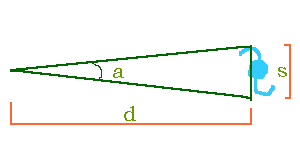
|
 |
THE HUBBLE LAW |
Measurements of Velocities and Distances |
|---|

|
 |
The quantity on the left side of this equation is usually called the redshift, and is denoted by the letter z.
| The formula for redshift should remind you of the process where you calculated your percentage error: [(your value) - (true value)] / (true value). Thus, we can view the redshift (at least for those galaxies with a recessional velocity much less than the speed of light) as a "percentage" wavelength shift. It is a measure of the ratio between the velocity of the galaxy and the speed of light. |
For Example: A certain absorption line that is found at 5000Å in the lab (rest wavelength) is found at 5050Å when analyzing the spectrum of a particular galaxy. We first calculate z:
redshift = [(measured wavelength) - (rest wavelength)] / (rest wavelength) We find that z = 50/5000 = 0.001 and conclude that this galaxy is moving with a velocity v = 0.001 * c = 3000 km/sec away from us.


The angular size of the galaxy (in milliradians; 1 mrad = 0.057 degrees = 206 arcseconds) will be displayed; write this number down on your data table given in the student answer sheets, under "Galaxy Size."Take a look at this schematic of a galaxy viewed from three different angles. Thought question: We assume that the spirals are all round, and that their different shapes are simply because we are viewing them from different angles. When measuring the angular sizes of the galaxies, why should you measure along the longest axis only?
If, at any point, you make an error while you're measuring (e.g. a mis-click), simply click on the "back" button of your web browser and take the measurement again.
| Details for the manipulation of the units to come out with the correct distances |
|---|
|
From calibrations, we know that galaxies
of the type used in this lab are about 22 kpc
(1 kiloparsec = 1000 pc) across. We may then find the distance to the galaxies: or equivalently, upon multiplying the left side by 1000 and dividing the right side by 0.001 (which is exactly the same thing): |
| Note that we now have the equation in a form where we can simply substitute the size in kpc (22) and divide it by the angle returned by our measurements (already in mrad). |